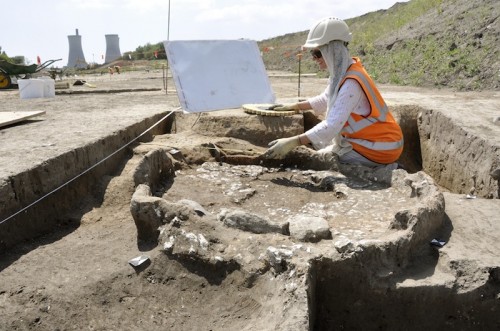Zone 6 of the East Kent Access road scheme, situated along Ebbsfleet Lane, has provided us with the greatest concentration of archaeological features yet seen on this project. It is also the most concentrated area of multi-period activity that I have seen during nearly twelve years of exploring Thanet’s wonderful archaeological heritage.
Inspired and helped by Kent pottery analyst Nigel Macpherson-Grant, I’ve been trying to get to grips with the pottery sequence in East Kent for some years now and I was delighted when Paul Murray asked me to do some preliminary spot-dating of the pottery coming out of the excavations on Zone 6. A great opportunity for me to learn more; a brave and bold strategy by Oxford-Wessex!
The archaeologists working hard and under strict time-pressure on Zone 6, have already uncovered wonderful things. With regards to the pottery, the earliest pottery identified so far dates to the Middle Bronze Age circa 1550-1350 BC. Peter Cichy discovered a virtually complete inverted urn of classic Middle Bronze Age style. A slightly unusual rim sherd from a large vessel of potentially the same date was recovered from a nearby ditch by Pete Lovett. Importantly, these two vessels might have been decorated using the same tool and this may provide us with a rare opportunity of identifying vessels made by the same prehistoric potter! Further work is required however.
Some of the pottery may give evidence of activity in the Late Bronze Age and Earliest Iron Age c.1100-600 BC, though certainly identified sherds are few at present and, again, more work is required. A major burst of activity occurred during the Early-Mid Iron Age c.550-350 BC and the quantity of pottery recovered suggests that it was at this time that the area of Zone 6 first became the focus of an actual settlement. From this period onwards the pottery evidence suggests that there may have been a relatively constant presence of human settlement activity, through to the Late Iron Age, Roman Conquest and Roman periods.
Ditches, pits and post-holes attest to the different phases of activity and it is the presence of a settlement which may have existed at the time of the Roman Conquest which could prove to be of particular significance. The archaeology in Zone 6 may allow us to perceive the evolution of a multi-period Iron Age site, influenced by contacts with the Continent, to a Late Iron Age site influenced by a more Romanised Continent, to a settlement which may have seen the arrival of the Romans in Kent. How this settlement was organised in the Early Roman period, along with the changes in the pottery and the other artefacts that remain, may allow us some important insights on how and to what degree the Roman world influenced the Iron Age inhabitants of this significant location on the Isle of Thanet.
Late Roman pottery of at least c.250 AD in date has been recovered, but at present the majority of the ceramics appear to date to the Earlier Roman period, perhaps particularly the 2nd century AD. Coins of 4th century AD date have been identified by Simon Holmes, so some degree of Late Roman activity continued in this area. A single sherd of c.7th century AD Anglo-Saxon pottery has been recovered from a post-hole and this is at present the most recent piece of pottery yet identified from Zone 6.
Paul Hart 24/25.07.10







